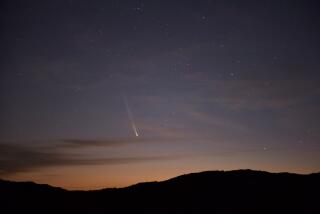NASA Spacecraft Plays David to Speeding Comet’s Goliath
- Share via
NASA’s Deep Impact spacecraft is closing in on its historic rendezvous with comet Tempel 1, a culmination of what Jet Propulsion Laboratory Director Charles Elachi called “one of the most daring and risky missions” the lab had ever undertaken.
If all goes well, the spacecraft’s 820-pound impactor will smash into the comet’s core at 10:52 p.m. PDT today. The cosmic collision and its aftermath will be observed by three telescopes in orbit and every major telescope on the Earth’s surface.
Images of the collision will provide not only “the most detailed pictures we have ever seen of a comet,” but also a first glimpse of the material inside a comet, said Lindley Johnson, the program executive. That, in turn, could give valuable new information about the formation of the solar system.
Researchers at JPL in La Canada Flintridge “are all sitting on the edge of their seats,” said Rick Grammier, the project manager. “If I could bottle all the adrenaline I’ve seen in the last couple of days, I wouldn’t have to sleep for a year.”
Their target is a “jet-black, pickle-shaped icy dirtball the size of Washington, D.C.,” said JPL’s Don Yeomans, a co-investigator for the mission. It is about 9 miles long and 3 miles wide.
Deep Impact’s goal of crashing a small probe into a comet is unprecedented. Scientists have compared the mission to trying to hit one speeding bullet with a second, while trying to observe the process with a third bullet.
That’s not quite a fair comparison, Elachi said. The spacecraft and comet are actually moving 20 times faster than the fastest bullet. To make it even more challenging, he added, scientists want to strike Tempel 1 on its sunny side so they will be better able to observe the effects of the collision.
“There are no trails for us to follow,” he said.
So far, the mission has gone perfectly. Deep Impact, launched on a Delta II rocket from Cape Canaveral Air Station in Florida on Jan. 12, has been streaking across the solar system at nearly 50,000 mph to intercept Tempel 1 near its perihelion -- the closest point in its orbit to the sun -- just short of the orbit of Mars, about 83 million miles from Earth.
After it releases the impactor, the compact-car-sized mothership will fire its thrusters to slow down by about 220 mph so that it misses the comet, coming no closer than about 300 miles from the comet’s nucleus.
The battery-powered impactor, which has its own guidance system and thrusters, will settle into Tempel 1’s orbit, waiting to be overtaken from behind at a relative speed of about 23,000 mph. It is capable of making three maneuvers on its own over the last two hours to ensure that it strikes the comet properly.
The craft will take a series of progressively sharper pictures of the nucleus and transmit them to the mothership for relay to Earth. The last one could be snapped as little as three seconds before impact, said Monte Henderson, Deep Impact program manager for Boulder, Colo.-based Ball Aerospace & Technologies Corp., which built the craft.
Meanwhile, the mothership will be monitoring the collision and aftermath with its own telescope and other instruments to identify the composition of ejected materials.
If the impactor fails to separate from the mothership, engineers will crash the entire assembly into the comet, Grammier said. That will yield a larger impact but produce somewhat less information, he said.
Images from Deep Impact should be spectacular, Yeomans said. The 1986 Giotto spacecraft that flew by Halley’s comet could resolve objects about twice the size of a football field. The 2004 Stardust mission to comet Wild-2 could reveal objects about a quarter of the size of a field.
“Deep Impact will resolve objects the size of a football,” Yeomans said.
Comets are valuable scientifically because they are leftover matter from the planets’ formation about 4.6 billion years ago. They have circled the sun on the fringes of the solar system ever since. Occasionally, gravitational forces perturb a comet’s orbit, making it drop into the inner solar system, where it circles the sun several times before dissipating.
The materials inside Tempel 1’s nucleus “have not seen the light of day for 4.6 billion years,” said Jessica M. Sunshine, a co-investigator from San Diego-based Science Applications International Corp.
They are a perfectly frozen specimen from our distant past.
“It’s pretty well certain we are, in fact, made up of cometary stuff,” Yeomans said.
The probe has already yielded information. Imaging of the comet’s gaseous corona with an infrared spectrophotometer has shown that the corona’s composition is similar to that of Halley’s comet, a mixture of water vapor, carbon monoxide, carbon dioxide and complex hydrocarbons, Sunshine said.
That spectrometer will be used to determine the composition of the comet’s interior when it is vaporized by the impactor. The impactor is made primarily of copper -- which scientists are sure is not present in the comet -- so that it will not interfere with identification of the comet’s constituents.
The craft has also imaged several outbursts of gases from the comet on its approach. Such outbursts are thought to be common, but are rarely seen because they dissipate quickly. Already, the team has shown that one outburst doubled the concentration of water vapor in the comet’s corona, Sunshine added.
The impact will not be visible from Earth with the naked eye, but should be visible with a telescope from Arizona and Southern California. Tempel 1 can be seen in the constellation Virgo, close to Jupiter.






